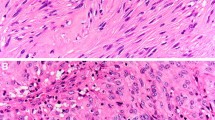Abstract.
Gastrointestinal stromal tumors (GISTs) are the most common mesenchymal tumors of the gastrointestinal (GI) tract. They are defined here as KIT (CD117, stem cell factor receptor)-positive mesenchymal spindle cell or epithelioid neoplasms primary in the GI tract, omentum, and mesentery. GISTs typically present in older individuals and are most common in the stomach (60–70%), followed by small intestine (20–25%), colon and rectum (5%), and esophagus (<5%). Benign tumors outnumber the malignant ones by a wide margin. Approximately 70% of GISTs are positive for CD34, 20–30% are positive for smooth muscle actin (SMA), 10% are positive for S100 protein and <5% are positive for desmin. The expression of CD34 and SMA is often reciprocal. GISTs commonly have activating mutations in exon 11 (or rarely exon 9 and exon 13) of the KIT gene that encodes a tyrosine kinase receptor for the growth factor named stem cell factor or mast cell growth factor. Ligand-independent activation of KIT appears to be a strong candidate for molecular pathogenesis of GISTs, and it may be a target for future treatment for such tumors. Other genetic changes in GISTs discovered using comparative genomic hybridization include losses in 14q and 22q in both benign and malignant GISTs and occurrence in various gains predominantly in malignant GISTs. GISTs have phenotypic similarities with the interstitial cells of Cajal and, therefore, a histogenetic origin from these cells has been suggested. An alternative possibility, origin of pluripotential stem cells, is also possible; this is supported by the same origin of Cajal cells and smooth muscle and by the common SMA expression in GISTs. GISTs differ clinically and pathogenetically from true leiomyosarcomas (very rare in the GI tract) and leiomyomas. The latter occur in the GI tract, predominantly in the esophagus (intramural tumors) and the colon and rectum (muscularis mucosae tumors). They also differ from schwannomas that are benign S100-positive spindle cell tumors usually presenting in the stomach. GI autonomic nerve tumors (GANTs) are probably a subset of GIST. Other mesenchymal tumors that have to be separated from GISTs include inflammatory myofibroblastic tumors in children, desmoid, and dedifferentiated liposarcoma. Angiosarcomas and metastatic melanomas, both of which are often KIT-positive, should not be confused with GISTs.
Similar content being viewed by others
Author information
Authors and Affiliations
Additional information
Electronic Publication
Rights and permissions
About this article
Cite this article
Miettinen, M., Lasota, J. Gastrointestinal stromal tumors – definition, clinical, histological, immunohistochemical, and molecular genetic features and differential diagnosis. Virchows Arch 438, 1–12 (2001). https://doi.org/10.1007/s004280000338
Received:
Accepted:
Issue Date:
DOI: https://doi.org/10.1007/s004280000338




